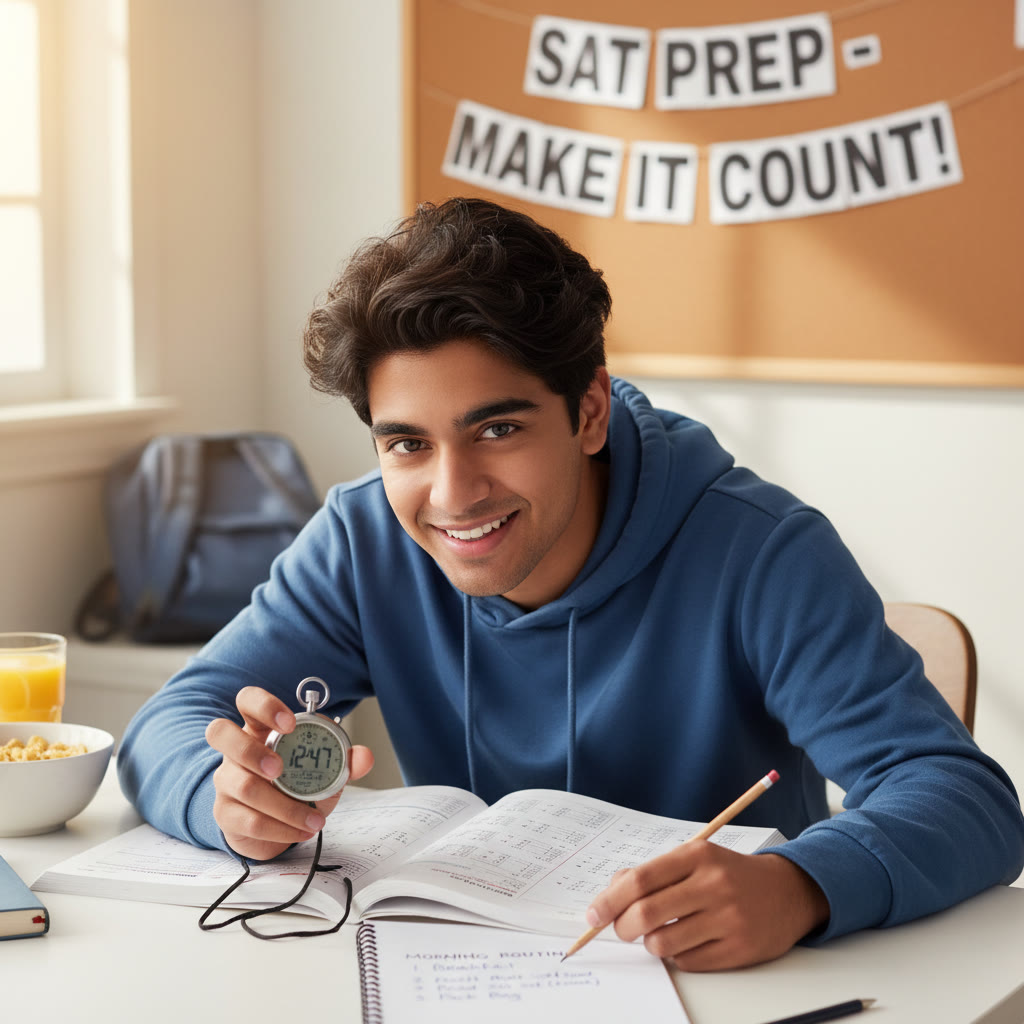How a Morning Routine Supercharges SAT Prep
There’s something quietly powerful about the first hour after you wake up. It’s when the brain is fresh, decision fatigue is low, and a small, deliberate routine can set the tone for hours of focused study. If you’re preparing for the SAT, a thoughtfully designed morning routine isn’t just a feel-good ritual — it’s an evidence-backed strategy that improves retention, sharpens attention, and helps you practice under ideal cognitive conditions.
Why mornings matter for SAT practice
Mornings are prime time for the kind of learning that sticks: active recall, targeted problem-solving, and concentrated reading. After a good night’s sleep, your brain consolidates memory. When you use that morning window to revisit tricky math concepts or practice reading passages, you’re more likely to make durable gains than if you cram late at night.
Beyond biology, morning routines reduce friction. When your first actions are pre-planned — a warm-up passage, ten focused practice problems, a slow, nutritious breakfast — you remove decision-making and preserve mental energy for actual studying.
What an effective SAT morning routine aims to do
- Prime cognitive resources: wake up the brain without draining it.
- Target weak areas with short, high-value practice.
- Build consistency: repeated small efforts beat rare, long marathons.
- Simulate test conditions occasionally: timed short blocks to build pacing.
- Track and adapt: use quick post-session notes to steer your next steps.
Components of a morning routine that actually work
1) Sleep and wake timing — your foundation
No routine survives a sleepless night. For most students, 7–9 hours of quality sleep is non-negotiable. Consistency is key: wake and sleep within a similar window each day, even on weekends when possible. If your test is early in the morning, begin aligning your schedule weeks in advance so your circadian rhythm is accustomed to peak alertness at exam time.
2) Quick, energizing movement
Five to fifteen minutes of light exercise does wonders. A short walk, dynamic stretches, or a 10-minute yoga flow increases blood flow to the brain without burning through glycogen. This isn’t about heavy training — it’s about priming your nervous system so concentration feels effortless.
3) Nutrition and hydration
A balanced breakfast is fuel. Think protein + complex carbs + healthy fat: Greek yogurt with fruit and nuts, eggs and whole-grain toast, or oatmeal with almond butter. Avoid sugary cereals or drinks that spike and crash. Hydration matters: a glass of water first thing helps wake you up and supports cognitive performance.
4) A 10–20 minute cognitive warm-up
Before deep work, warm the brain. Here are easy options:
- Read a short, dense non-fiction paragraph and summarize it aloud.
- Solve 5–10 quick math problems focusing on speed and accuracy.
- Do a short timed writing prompt (3–5 minutes) to practice clarity under time pressure.
Warm-ups both reduce anxiety and cue your brain that this is focused study time.
5) Targeted practice block
This is the heart of the routine: 25–60 minutes of focused study on one SAT skill — for example: algebraic manipulation, passage-based inference questions, or grammar rules in context. Use active strategies: try solving a problem before checking the solution, explain your reasoning aloud, and annotate reading passages to find the author’s structure.
6) Quick review and goal-setting
Take 5 minutes to log what you did, one specific mistake to avoid, and one goal for the next morning. A short error journal is gold: over weeks you’ll see patterns and make smarter practice choices.
Sample morning routines: pick your window
Different students have different schedules. Below are three practical templates you can adopt depending on how much time you have in the morning. Use them on study days or to replace a low-effort session when you’re pressed for time.
| Routine Length | What to include | Why it works |
|---|---|---|
| 30 minutes |
|
Fast, consistent practice that fits into busy schedules — great for building habit. |
| 60 minutes |
|
Balanced routine that allows deeper work while still being manageable daily. |
| 90 minutes |
|
Allows simulation of test sections and deeper consolidation — great for weekend or intensive days. |
How to choose the right length
If you have a packed school day, start with 30 minutes and build toward 60. If your mornings are more flexible, 60–90 minutes unlocks higher-quality practice and occasional full-section simulation. Whatever length you pick, consistency beats occasional marathons.
Specific exercises and warm-ups that pay off
Reading & Writing warm-ups
- Read one paragraph from a non-fiction article and write a two-sentence summary. This trains main-idea extraction and concision.
- For grammar: pick 5 sentences and identify the one grammatical error or improvement each sentence needs.
- Highlight transition words while reading to practice tracking the author’s structure.
Math warm-ups
- Practice mental math drills for 5 minutes: fractions, percent conversions, square roots — speed counts on the SAT.
- Choose one problem type you’ve recently missed and do 4 problems back-to-back, focusing on solving steps rather than only answers.
- Time a short, calculator-free problem set to practice pacing and reduce reliance on the calculator for easy steps.
Pacing, breaks, and avoiding burnout
Short breaks are catalysts, not distractions. Use 5–10 minute pauses between focused blocks to move, hydrate, or practice breathing. Avoid broad social media browsing — set a clear checkpoint (e.g., after your study block) before checking notifications.
Pomodoro-style segments (25 minutes work, 5 minutes break) are a natural fit for SAT study because they mirror concentration spans and encourage sustained effort without fatigue.
Tracking progress: the simple weekly review
Every Sunday (or your chosen day) do a 15–30 minute review of the week:
- What improved? (speed on no-calculator problems, fewer grammar errors, etc.)
- What persisted? (types of mistakes repeating)
- What will you prioritize next week?
Pair this with one simulated section under timed conditions each week or biweekly. There’s no substitute for timed practice: it trains pacing, endurance, and stress management.
Personalization: make the routine your own
One-size routines fail because they ignore the person doing the practice. Personalization means adjusting the length, changing the order (some people are sharper after movement; others need a caffeine-free approach), and aligning practice with your target score and date.
This is where guided support can accelerate progress: Sparkl’s personalized tutoring pairs expert tutors with AI-driven insights to create tailored study plans, refine morning routines based on your performance patterns, and give 1-on-1 guidance to rapidly close score gaps. Having a coach who can point out blind spots — for example, consistent misreads of data in graphs — turns routine practice into strategic improvement.
Practical tips to build and keep the habit
- Start small: commit to just 10 minutes each morning for a week, then increase.
- Ritualize one object: a special notebook or a particular mug signals “study time.”
- Batch decisions: lay out your clothes, prepare breakfast ingredients, and queue your warm-up the night before.
- Use visible cues: stick a one-line goal on your mirror (“Today: focus on function notation”) so you don’t forget.
- Celebrate consistency, not perfection: five straight days of 30 minutes is better than an exhausting 6-hour day and three skipped mornings.
When things don’t go as planned
Missed a morning? Don’t double down by cramming more later — that’s a shortcut to burnout. Instead, do a focused mini-session in the evening or rearrange the next morning. The important metric is average weekly time, not single-day perfection.
Real-world examples and scenarios
Imagine two students: Kayla and Marco. Kayla commits to 45 minutes each morning: 10 minutes jog+breakfast, 10 minutes reading warm-up, and 25 minutes targeted math practice. After six weeks she notices her speed on no-calculator problems improves because those quick mental math drills became habit. Marco, juggling a part-time job, can only do 20 minutes most mornings. He prioritizes vocabulary-in-context and two algebra problems — small, intense reps that reduce careless errors and keep momentum. Both improved not because they did the same thing but because they built a consistent, well-targeted routine that fit their lives.
Sample 4-week morning plan (what progress looks like)
This plan assumes 45–60 minute mornings 5 days a week with one full timed section on weekends. The idea: rotate focus, increase difficulty, and use reviews to close gaps.
- Week 1: Establish rhythm — daily warm-ups + focused block on high-frequency topics (linear equations, main idea passages).
- Week 2: Introduce timed mini-tests — track pacing and accuracy; add an error journal entry each day.
- Week 3: Increase difficulty — work on mixed problem sets, train on harder reading questions and evidence-based writing.
- Week 4: Simulate test conditions once, use mornings for targeted remediation of errors discovered in the simulation.
Repeat cycles like this, and each month of consistent mornings compounds into measurable score gains.
Tools and small investments that help
- A simple timer or Pomodoro app to enforce focus blocks.
- An error journal (notebook or digital note) — log the question type, mistake, and one fix.
- Practice materials: official practice questions are best, but variety keeps your mind flexible.
- Accountability partner, study group, or 1-on-1 tutor. A short weekly check-in with a tutor can keep your morning routine honest and efficient; Sparkl’s tutors specialize in turning morning momentum into measurable improvements through tailored study plans and AI-driven insights.


Putting it all together: a morning blueprint you can start tomorrow
Pick one routine length (30/60/90 minutes). Set one measurable goal for the week (e.g., reduce careless errors on algebra by 25%). Prepare the night before: lay out your materials, write the warm-up, and set a timer. When you wake up, follow the sequence: hydrate → move → warm-up → focused block → log. At the end of each week, review, adapt, and repeat.
Remember: this isn’t about rigid perfection. It’s about designing a morning ritual that respects your life, plays to your strongest hours, and translates incremental effort into lasting skill. With consistency, smart warm-ups, and focused blocks — plus outside support when you need it — your mornings can become a secret weapon on test day.
Final thoughts: make mornings yours
People love dramatic study hacks, but the real magic is small, repeatable actions stacked over weeks. A morning routine is more than a productivity trick; it’s a learning strategy that honors both brain science and real life. If you’re open to personalization and occasional expert guidance — including 1-on-1 tutoring, tailored study plans, and AI-backed feedback — your morning hours will be some of the most productive and confidence-building minutes in your SAT preparation.
Start simple tomorrow: pick one warm-up, one focused block, and one logging habit. Keep it kind, keep it consistent, and watch how your preparation changes, one morning at a time.



















No Comments
Leave a comment Cancel